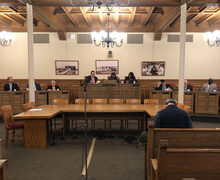Folk music doesn’t have to be totally traditional
Maggie Rogers’ recent song release, “Alaska,” proves that not all folk music has to be a guilty pleasure buried deep in the recesses of my iPod, never to be listened to in public. She’s modernizing folk, and the sound is interesting and intense. Rogers is more folk influenced than actual folk, but “Alaska” is good, filled with delicate vocals and an interesting composition. It could be the start of something great.
But don’t just take my word for it — Pharrell Williams think so, too. Last year, Rogers was featured in a viral YouTube video where the “Happy” singer critiqued students’ work as a part of a masterclass at New York University’s Clive Davis Institute of Recorded Music. Unlike other singer-songwriters in the class, Pharrell had nothing but praise for Rogers and a complete look at bafflement and awe as she played the tune for him.
“Wow. I have zero, zero, zero notes for that,” Williams said about the song.
Rogers is kind of weird, too. She plays the banjo and she’s lived in France. She started playing the harp at age seven. She loves nature, and is a self-proclaimed optimist. Her music relies heavily on house beats and mixes, but the lyrics are super folk-inspired. As a producer of her own sound, she’s in a unique position to have a distinct handle in the way the world perceives her music. Being a bit of a contradiction is a good thing. It’s interesting.
But Rogers isn’t the first to take a singer-songwriter sound and back it up with interesting production. Indie darling Ryn Weaver also made New York her home while writing her own album, and “OctaHate,” was endorsed by big names like Charli XCX and the lead singer of Paramore, Hayley Williams. Indie artists are finding more success when endorsed by pop stars, even though their genres are completely different.
Maggie Rogers’ “Alaska” has over 800,000 views on YouTube since its release — which is huge for anyone just starting out. It might be the beginning of something, but it proves there is a place for music that doesn’t fit the norm. Maybe it won’t be played on the radio — but people, even big-name artists can appreciate singers that can write and play interesting music.
And, yes, some of that is just plan luck. Rogers was taking a class and Williams liked her stuff enough to talk about it. But there’s also skill involved — Rogers wrote the song and produced it.
In the age of the internet, being discovered is easier than ever, and what that means for indie artists is that while their place may not be on the radio, there are others to find success. It’s not as streamlined as it was before, artists have options. Artists have the power to control their own sound, choose where and when to put it up there, and capture audiences by simply being talented.
“Alaska” is an interesting folk tune filled with potential. It’s proof that there is a place for alternative music, for sounds outside the norm. “Alaska” is hopefully the start of a great album, and a greater career for Rogers. I’m certainly looking forward to hearing more.
Emera Riley is a junior magazine journalism major. Her column appears weekly in Pulp. You can email her at elril100@syr.edu.
Published on October 25, 2016 at 9:11 pm






